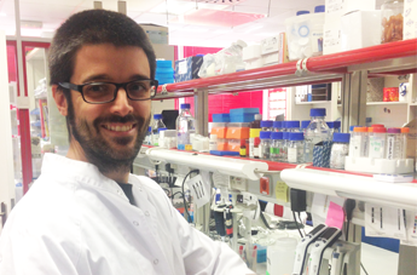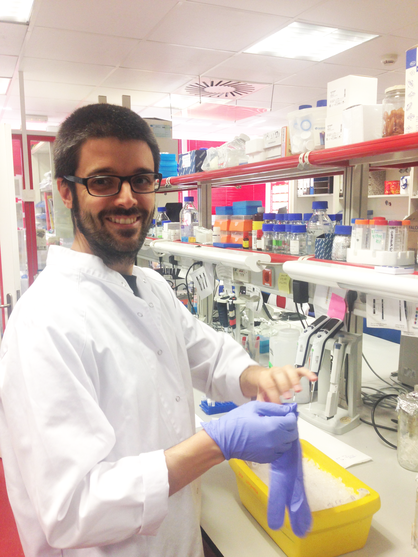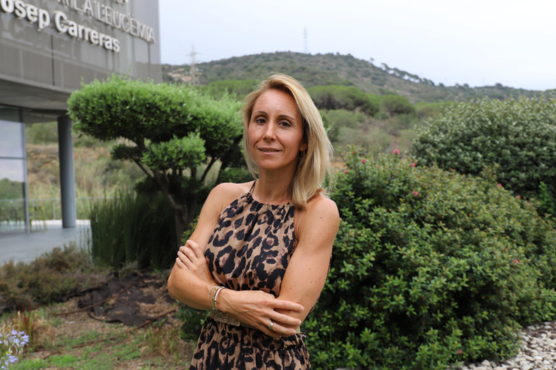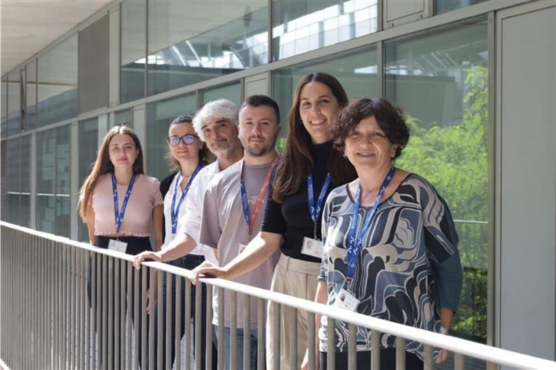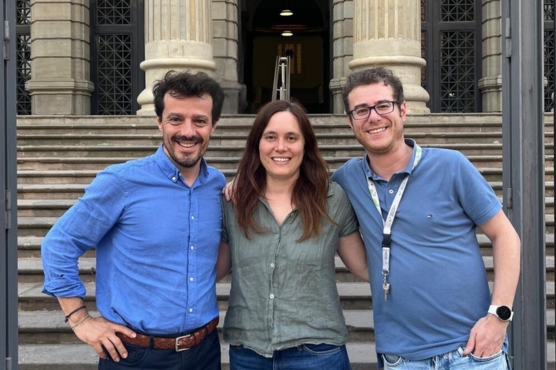Raul Torres is a member of one of our research groups in our Campus Clínic-UB of the Josep Carreras Leukaemia Research Institute. He just received a support of the “Lady Tata Memorial Trust” to continue his project in our center. We want to know a little more about him and his work …
Raúl Torres is 36 years old and is from Madrid. He loves music, sport, cinema and handicrafts and is a member of one of the research teams at the Josep Carreras Leukaemia Research Institute‘s University of Barcelona Hospital Clínic Campus.
He is a researcher specialised in the study of DNA, cell biology and genome engineering, and describes himself as being friendly, hard working and having a keen sense of curiosity and perseverance. He has just been awarded financial support by the Lady Tata Memorial Trust to continue with his project at our centre. Today we wanted to get to know a little more about him and his work.
– You have recently been awarded a considerable amount of funding to continue with your project for another year. What do you think about that? How do you feel?
The fact is that it is great recognition not just for me but for all the work that is being done in the laboratory of Dr. Pablo Menéndez. It is a very promising line of research and with it we hope, in the future, to be able to elucidate key questions concerning the oncogenic processes involved in infantile leukaemia and be able to transfer this knowledge, with great caution and in the medium to long term, to clinical treatment. Obviously I am very happy and very pleased to have received this support.
– Could you tell us, in terms a layman can understand, about the research you are doing at the IJC?
The project is based on generating a human cell model for infantile acute lymphoblastic leukaemia with t(4;11)/MLL-AF4 translocation. This aggressive subtype of infantile leukaemia has a 5 year survival rate of less than 35%. Until now it has been impossible to discover which cell causes this cancer in children and that is why part of the project is focused on determining the original cell in which the translocation takes place and the possible secondary events that cooperate in the oncogenic process.
– How did you come to focus on this kind of infantile leukaemia?
My professional career has been based on the development of tools that make it possible to study the basic biology of various kinds of human pathology. I was specifically interested in this kind of leukaemia, about which key points are still unknown, something that makes it a very interesting and stimulating disease to study. The study of this disease represents a difficult challenge, but far from discouraging us, that is what drives us on in the search of answers that will benefit patients.
– How would you describe a research centre like the IJC? Why is it interesting?
I think the Josep Carreras Leukaemia Research Institute is a research centre of the first magnitude focused on the study of leukaemias and with top-class researchers working in a setting that is competitive, international and enriching. It is interesting because it puts people from different professional backgrounds together to focus their work on the study of leukaemia from different points of view.
– What is your working day like?
Well, I get up around 7 a.m., have a shower and breakfast and get the kids ready for school. When I’ve taken them there, I go to the research centre where I start my working day. As soon as I arrive I organise my timetable for the day and decide on the tasks to be tackled during the day. Normally my day is organised so that I can carry out experiments in the laboratory in the morning, leaving the afternoon with time to read scientific publications, write things up, or discuss matters arising from our work with colleagues.
When the working day is over, I go and collect the kids from school and spend the rest of the evening with them. Although it might look as if that is the end of a researcher’s working day, it isn’t. I usually then spend some time replying to emails, reading a couple of more articles and, if there is still time, maybe watch a TV series or a film.
– What do you most and least like about your work?
What I most like is, without doubt, the challenge facing you to find answers to difficult questions. Relationships with other colleagues is another strong point and the fact that you learn new things all the time. What I least like about it is the situation in which science currently finds itself, that it is perceived as not being really necessary in this society, that it is not something to invest in, to stand up for.
– What are the challenges facing you in the research you will be doing over the next five years?
As I mentioned before, my main challenge is to find answers to questions concerning infantile leukaemia. Another challenge is to find long-term funding so I can devote myself entirely to this project without having to worry about finding short-term funding in order to continue.
– How do you see yourself in 20 years’ time?
I know it’s difficult but I would like to be directing a research group, answering questions and, well, doing research.
– What qualities does research in other countries have, such as the US, that you think are lacking in Spain?
Support and funding for research are continuous. There is support both for basic and translational science. And there is much more of a scientific culture as a basis in both the schools and colleges.



